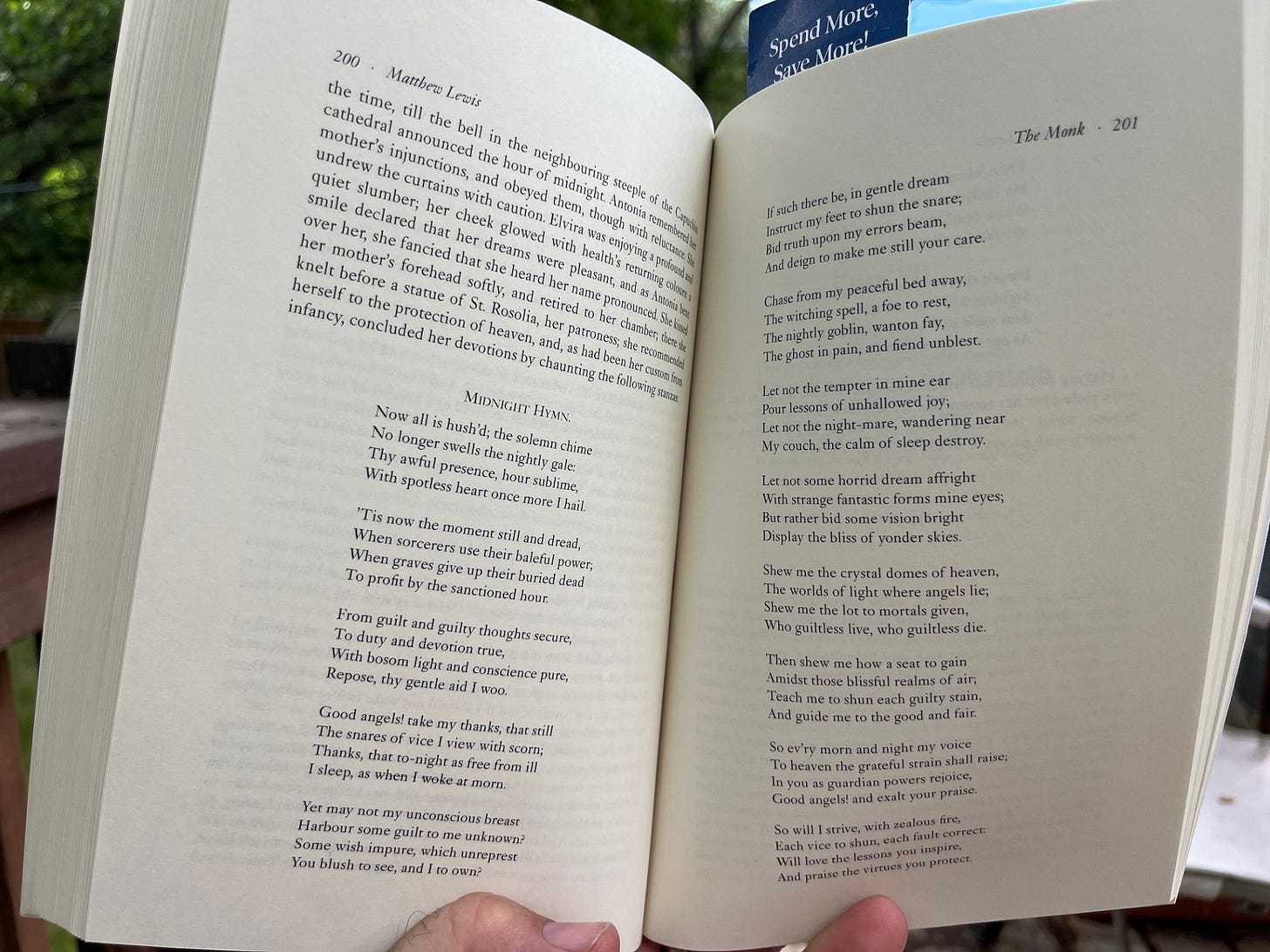Hello all-
The move from South Carolina to Saskatchewan is complete. Some parts went well, while other parts were a nightmare (don’t get me started). We’re mostly unpacked but still mostly disorganized, so it’s still going to be a bit before I’m posting with regularity again.
_______
“But a few weeks had elapsed, since he was pure and virtuous, courted by the wisest and noblest in Madrid, and regarded by the people with a reverence that approached idolatry. How now saw himself stained with the most loathed and monstrous sins, the object of universal execration, a prisoner of the Holy Office, and probably doomed to perish in tortures the most severe.”
Because life is too short to read bad books, I offer my thoughts on literature that crosses my path, both classic and contemporary. I Just finished reading The Monk, which is considered an all-time British Gothic classic and an early example of the horror genre, predating Frankenstein and Dracula and arriving only 28 years after The Castle of Otranto. The author, Matthew Gregory Lewis, was 20 years old when it was published in 1796, the same year that he was elected to Parliament - apparently being a member of the House of Commons didn’t require a lot of experience in those days. When The Monk was published, the amount of immorality and blasphemy portrayed therein resulted in controversy and censorship, and some blame it for torpedoing Lewis’ political career. It was also a runaway success, inspiring a ton of lame knock-offs, and at least one novel written as an angry response to Lewis.
It seems a bit silly to me to issue a Spoiler Warning for a piece of literature that came out the same year that George Washington published his farewell address, but I’ll do it anyway. While I will avoid the surprise twists (and my goodness, some of those twists are messed up), I will be discussing the plot of the book, including how it ends. So there you go; you have been warned.
The Monk features the interlocked destinies of three couples. First, we have Ambrosio and Matilda. Ambrosio (the eponymous monk) is a handsome Capuchin monk who had been found as a baby abandoned on the doorstep of an abbey in Madrid, Spain, and raised by the holy brothers. He has never set foot outside the abbey walls, and is famous for his superhuman righteousness and oratorical skill. Ambrosio is hero-worshiped by a young monk who confesses to being a woman in reality (real name: Matilda). Matilda had disguised herself as a boy to gain admittance to the monastery and be near her idol.
Our second couple is Lorenzo and Antonia. These two met when they attended a sermon given by Ambrosio, and it’s love at first sight. Lorenzo is a dashing and romantic young nobleman, and Antonia is a naive and innocently-virtuous young woman with no good marital prospects, who might or might not end up in a convent.
Couple Number Three is even more so. Here we have Lorenzo’s best friend Raymond (who is more dashing, more romantic, and born to a high stratum of nobility) and Lorenzo’s sister Anges (who is more naive and more innocently-virtuous, and who also has no good marital prospects and might or might not end up in a convent). Their love-at-first-sight moment happened when Raymond was traveling (incognito, because of course he was).
Will love conquer all? Don’t get your hopes up. It’s about to get dark and weird.
Through various machinations (including the well-known mind-control powers of breasts), Matilda manipulates Ambrosio into betraying his vow of chastity, setting him to a path to destruction. One sin leads to another, and then another, until Ambrosio has committed rape and multiple murders, dabbled in sorcery, and sold his soul to the Devil (Schmuck move, dude. Never trust a contract made with the Father of Lies).
Agnes has taken her vows as a nun in the convent that adjoins Ambrosio’s monastery, but is also pregnant with Raymond’s child (oops). Raymond, meanwhile, has his own problems that keep him from Agnes, including an accidental elopement with the ghost of a dead woman (Suddenly I’m in the mood to watch Corpse Bride again).
Lorenzo is doing everything he can to help his friend and his sister, while trying to get his family’s blessing to marry Antonia. Antonia, meanwhile, has her own family problems, and to top it off, Ambrosio is now wallowing in lust and has set his sights on Antonia. With or without her consent, Ambrosio is determined to possess Antonia, by any means necessary.
I purchased The Monk because it appears on multiple “Best Horror Novels Ever” lists. The horror, however, only comes to us in tidbits. We have a dark and creepy castle, a hideous dungeon, and a foul cemetery. The subplot with Raymond’s ghost girlfriend (known to the inhabitants of the creepy castle as The Bleeding Nun) is horrific. The final appearance of Satan in his true form is suitably monstrous. And the final fate of Ambrosio is both pitiable and gross (Seriously, it is an accomplishment to come up with something that almost makes me feel sorry for someone that evil, but Lewis pulls it off).
About 90% of the book, though, reads less like a horror story and more like a romantic melodrama. We have couples separated by miscommunications and misunderstandings, and the jealous scheming of others. We have late-night escapes (dark and stormy of course), a nobleman in disguise, damsels in distress, and heartsick lovers who take to their beds and lie in death’s shadow at the thought of being forever parted from their beloved. And poetry. So much poetry. Unnecessary poetry. On more than one occasion, the story comes to a screeching halt because somebody wrote or recites a poem, and the reader needs to see every line of it.
(Though I must say, I did enjoy “Alonzo the Brave and Fair Imogine.”)
If you approach The Monk with the idea that it is an 18th-Century Gothic romance with some horror elements, rather than expecting a horror story that happens to include a bit of romance, then you should find this an enjoyable read. In addition to what I already described, I also had fun with the humorous elements thrown in. The author goes a bit meta, having a character go off on how only fools write novels and poetry, because they are exposing themselves to idiots who feel qualified to criticize the work. We also have comic relief characters, such as one woman who is convinced that another character’s death is divine punishment for eating a chicken wing on Friday, and will NOT shut up about it. The narrator adopts a snarky attitude at times, throwing in sarcastic jabs at various targets. For example: “[S]he was wise enough to hold her tongue. As this is the only instance known of a woman’s ever having done so, it was judged worthy to be recorded here.” (The opinions expressed by Matthew Lewis do not reflect those of the author of this book review, and are included only as an example of the level of snark. The author of this book review requests that no heavy objects be thrown at him, and that all complaints against Mr. Lewis’ views relating to gender be directed to his departed spirit by way of the nearest summoning circle or Ouija board.)
Though not as horror-intensive as I’d hoped, I greatly enjoyed this book, I had fun with the emotionally overwrought melodramatic language employed, and found Ambrosio’s degeneration through temptation, sin, and death surprisingly psychologically realistic. In short, The Monk deserves its reputation as a classic Gothic novel, and is well worth your time.
_______
If you enjoyed this review, stick around and consider subscribing to get more reviews of new and classic books, as well as author updates and snippets of my own fiction.





